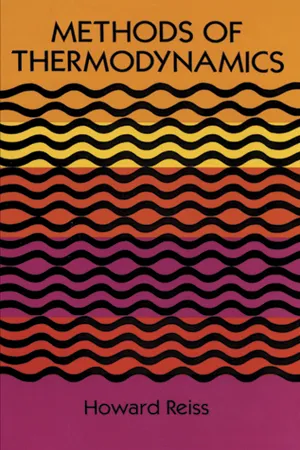1. General Remarks
The second law of thermodynamics may be stated in the following form:
For any thermodynamic system there exists a function of state which we shall call the entropy and denote by the symbol S. The method for measuring entropy is based upon the fact that corresponding to any change of state for the system conducted reversibly (quasistatically)
where Dq is the heat absorbed by the system during the reversible change and g(θ) is a definite but as yet unspecified function of the empirical temperature θ alone. Furthermore, for any change which can in fact take place in an isolated system,
(where the Δ stands for a finite change).
According to the definition presented in Chapter 3, Section 6, an isolated system is one which can exchange neither matter nor energy with its environment. This limitation may be achieved by surrounding the system with rigid adiabatic walls which are impermeable to matter.
The above statement of the second law is formal and abstract. Nevertheless, it is equivalent to other statements which may seem more deeply rooted in intuition. Notice that in many respects the second law is similar to the first. Like the first, which asserts the existence of a function of state, the internal energy, the second law asserts the existence of another function of state, the entropy. Furthermore, just as the first law prescribes a method for the determination of the internal energy (through the measurement of work performed adiabatically), the second law prescribes a method for the measurement of entropy through the application of Equation (4.1). Thus, the entropy difference between two states 1 and 2 is
where the integral is taken over a reversible or quasistatic path (a path which can be plotted in state space).
However, the inequality contained in Equation (4.2) is foreign to the first law. This part of the second law has valuable consequences.
The function g(θ) is not perfectly arbitrary but (except for a scale factor) is related in a perfectly definite way to other measurable physical quantities. However, the precise form of g(θ) need not be specified in the statement of the second law since, as we shall show below, it can be derived as soon as the method for measuring temperature is defined.
Many authors have sought to make the second law seem reasonable by appealing to the facts of experience. From the point of view of the pedagogue, the formal statement advanced above leaves much to be desired. Any attempt to base the second law in intuition, however, should make it clear from the start that the law cannot be proved. Like the first law, it is a postulate, albeit an eminently reasonable one.
The teaching of the second law presents an unending challenge to the pedagogue. Energy seems more real to the student than entropy for which his intuitive grasp comes less from everyday experience. It is also true that the student will have enjoyed some years of familiarity with energy before being called upon to grapple with entropy. In some approaches, the meaning of entropy is illustrated by an appeal to statistical mechanics where it is possible to relate entropy to the number of microscopic configurations of the system which are consistent with a single macroscopic (thermodynamic) state. In keeping with the declared purpose of this book, we shall not base our arguments on discussions of this kind.
Nevertheless, it is important to take some steps to make the bare statement of the second law contained in Equations (4.1) and (4.2) more satisfying intuitively. Such steps can in no way lead to a proof of the law but may make it seem more plausible. Since we need not concern ourselves with a rigorous proof, many liberties may be taken with the plausibility argument. Any path which maximizes our intuitive satisfaction is permissible. The next few sections will be devoted to pursuit of such a path.
2. Need for an Additional Extensive Function of State
A useful method for describing the concept of entropy is to show how it arises in a natural manner almost out of necessity.
Consider Figure 1.2, modified to the extent that the rigid walls of the container are made adiabatic rather than diathermic so that the system in the container is no longer in contact with the thermostat. Then the system is isolated in the thermodynamic sense. Neither energy nor matter may be exchanged between the system and its surroundings. In spite of this, one may by external intervention induce a change in the system. This may be performed by opening the lock, an act which may be accomplished without exchanging energy with the system since the lock and walls are not part of the system. We are left in the peculiar position of being able to influence the behavior of the system without being able to transmit to it a signal consisting of energy or matter or both!
In the example cited, the opening of the lock represents the removal of a constraint (see Chapter 1, Section 8); and the ability to influence a system without exchanging energy or matter is a characteristic feature of a constraint. In Figure 1.2 the process induced by opening the lock will involve the expansion of the gas on the left of the partition and the movement of the partition to the right. If the partition is frictionless and the gas itself exhibits no internal friction, then the partition will simply oscillate without being damped. The situation is similar to that which would occur in connection with the pendulum of Figure 1.3 if it were equipped with frictionless...



